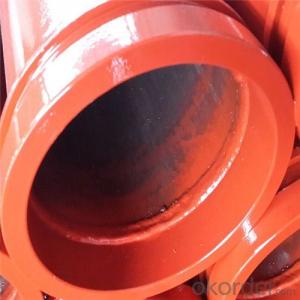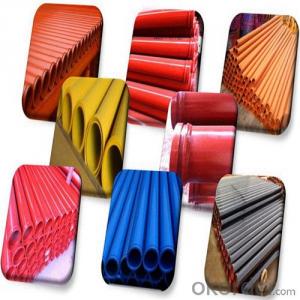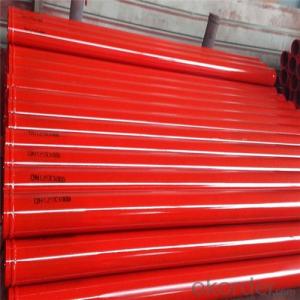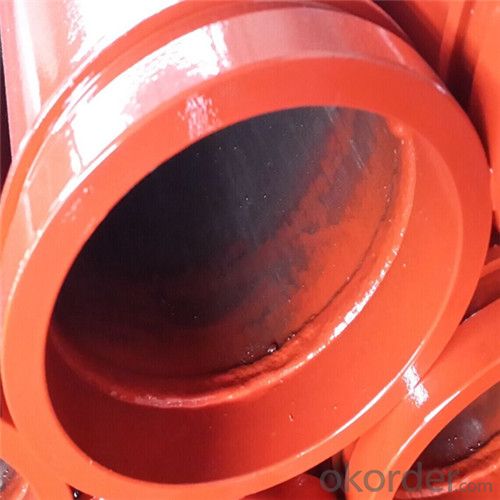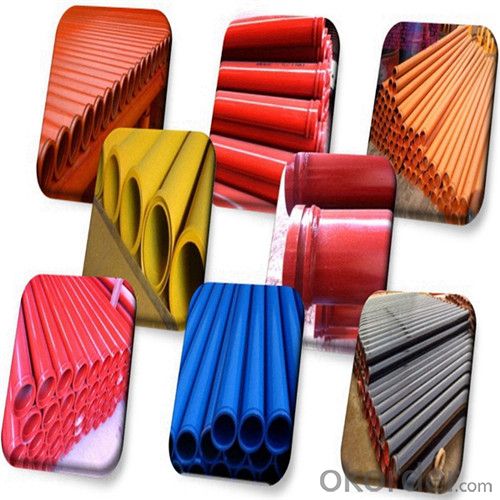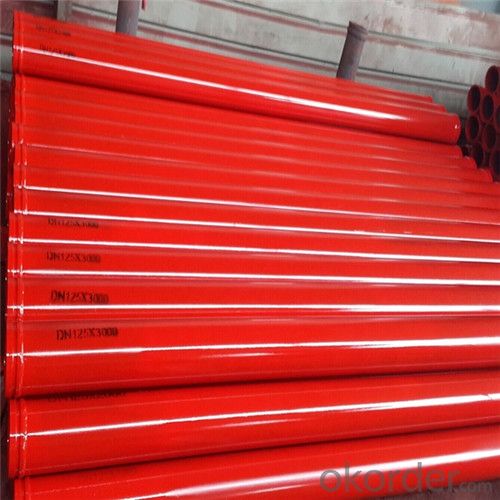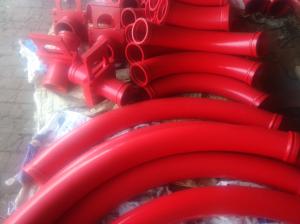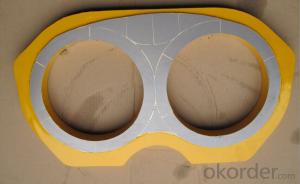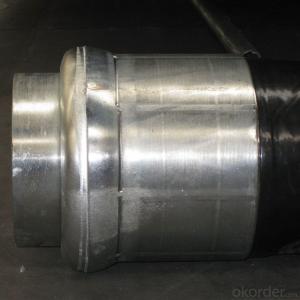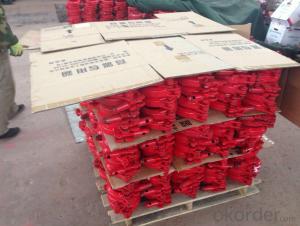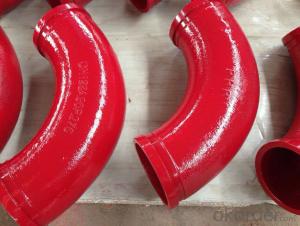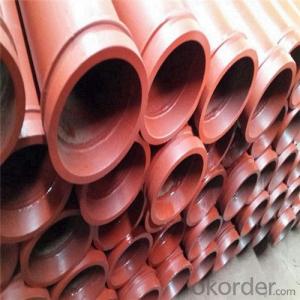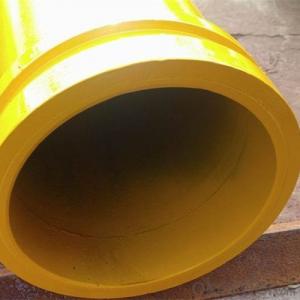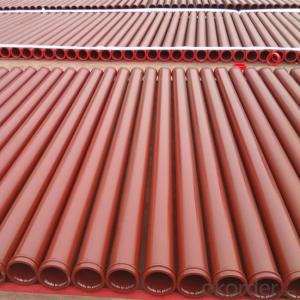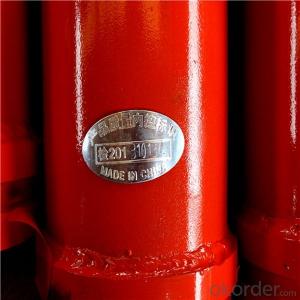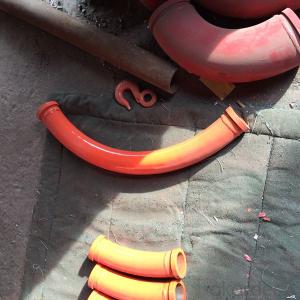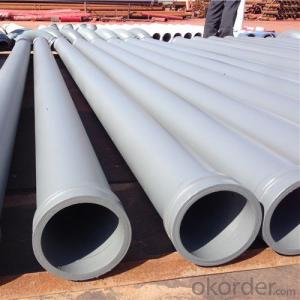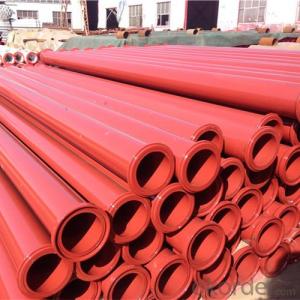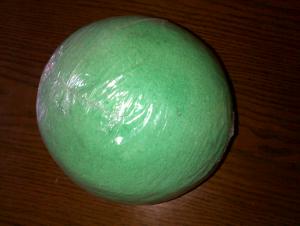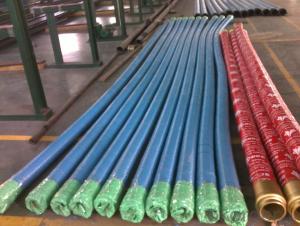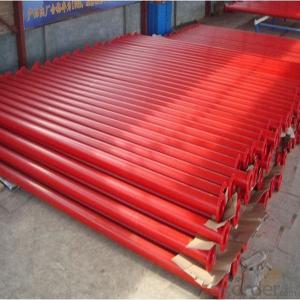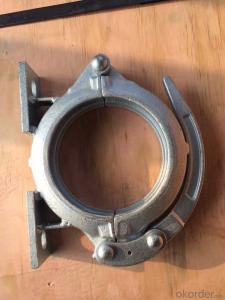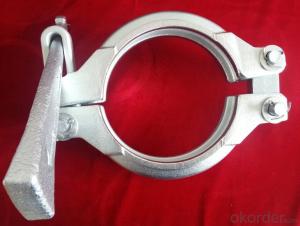3M Concrete Pump St52 Seamless Delivery Pipe
- Loading Port:
- Tianjin
- Payment Terms:
- TT or LC
- Min Order Qty:
- 50 pc
- Supply Capability:
- 5000 pc/month
OKorder Service Pledge
OKorder Financial Service
You Might Also Like
3M Concrete Pump St52 Seamless Delivery Pipe
1. Structure of 3M Concrete Pump St52 Seamless Delivery Pipe:
St52 Weld Pipe: Main use for Trailer-mounted pump, thickness has 4.0mm, 4.5mm, 5mm. Compare with for Truck-mounted pump. Weld pipe has cheaper price, so it is popular in Saudi, Pakistan, India, etc. Unit Price is about 30USD-33USD.
St52 Seamless Pipe: Now More People like use this kind for Truck Pump and Trailer Pump because of the quality is better and it is seamless kind, so this kind pipe is most popular in Middle East Price About 34USD-37USD.
Wear Resistant Pipe: Use for Truck Pump, Wear Resistant Layer is 2.5mm.Through heat treatment way make this pipe more strong (HRC60-62), Using Life: 25,000m³-35,000m³ Price about 65USD-68USD.
2. Main Features of 3M Concrete Pump St52 Seamless Delivery Pipe:
• In case of quality problem the company provide free replacement.
• Provide technical support for free.
• Provide consumers with regular visits
• Ensure the supply of ancillary parts
• Our company passed the ISO9000 certification, the product through 3C certification in full compliance with national standards
3. 3M Concrete Pump St52 Seamless Delivery Pipe Images

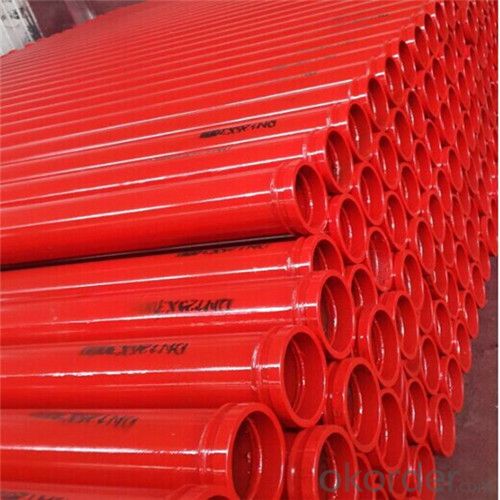
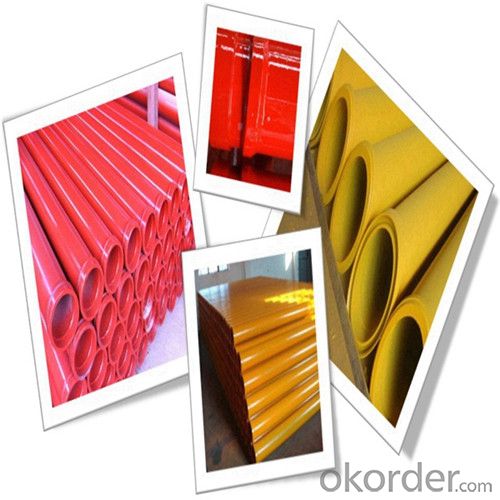
4. 3M Concrete Pump St52 Seamless Delivery Pipe Specification
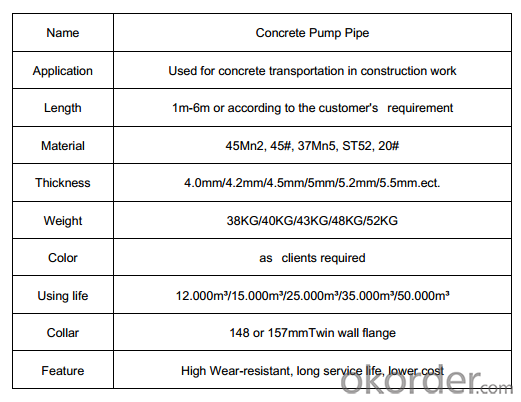
Production Process
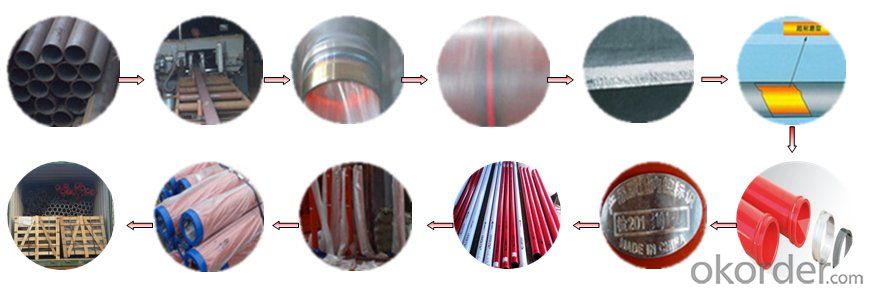
5. FAQ
We have organized several common questions for our clients, may help you sincerely:
①Is your products exported a lot?
We have exported to many, many countries. Every year we ship more than 30 containers of these spare parts. Our main market is in Middle-east, Asia & Africa.
②How to guarantee the quality of the products?
We have established the international advanced quality management system,every link from raw material to final product we have strict quality test;We resolutely put an end to unqualified products flowing into the market. At the same time, we will provide necessary follow-up service assurance.
③How long can we receive the product after purchase?
In the purchase of product within three working days, we will arrange the factory delivery as soon as possible. The specific time of receiving is related to the state and position of customers. Commonly 15 working days can be served.
6. Why choose us
• We are a comprehensive manufacturing and trading company.
• Our company is one of the biggest manufacturing and trading companies in China.
• We have been specialized in producing concrete pump spare parts and specialized in producing all kinds of concrete pump parts. As Concrete Pump Pipe, Concrete Pump Elbow, Concrete Pump Rubber Hose, Concrete Pump Wear Plate, Concrete Pump S Valve, Concrete Pump Piston and so on.
• We are famous for our superior quality, competitive prices, first-class craftworks, safe package and prompt delivery.
• We have been supplying concrete pump parts for SCHWING, PUTZMEISTER, SANY, CIFA, KYOKUTO, ZOOMLION for 10 years, so we can promise you the quality and best price.
- Q: How can a faulty filter affect the pumping process?
- A faulty filter can significantly affect the pumping process in several ways. Firstly, a faulty filter may become clogged or blocked, hindering the flow of fluid through the pump. This can result in reduced efficiency and increased energy consumption as the pump has to work harder to overcome the resistance caused by the clogged filter. The decreased flow rate can also lead to longer pumping times, which can be problematic in time-sensitive applications. Secondly, a faulty filter may fail to effectively remove impurities or contaminants from the fluid being pumped. This can be particularly problematic in industries where maintaining the purity or cleanliness of the fluid is crucial, such as in pharmaceutical or food processing applications. The presence of contaminants can compromise the quality of the final product or damage equipment downstream from the pump. Furthermore, a faulty filter can lead to increased maintenance and repair costs. If the filter is not functioning properly, it may allow larger particles or debris to pass through, which can cause damage to the pump components. This can result in increased wear and tear, decreased lifespan of the pump, and the need for more frequent repairs or replacements. Lastly, a faulty filter can also pose a risk to the overall system and its components. If the filter fails completely, it may allow foreign objects or particles to enter the pump, leading to potential blockages, damage to internal components, or even complete failure of the pump. This can result in costly downtime, loss of production, and the need for emergency repairs or replacements. In summary, a faulty filter can have detrimental effects on the pumping process, including decreased efficiency, compromised fluid quality, increased maintenance costs, and potential damage to the pump and system components. Regular inspection, maintenance, and timely replacement of filters are essential to ensure smooth and reliable operation of pumps in various industries.
- Q: How often should concrete pump pistons be inspected and replaced?
- Concrete pump pistons should be inspected regularly, ideally after every 200 to 300 hours of operation or at least once every three months. The frequency of replacement will depend on various factors such as the quality of materials being pumped, the pumping conditions, and the maintenance practices followed. However, as a general guideline, pistons should be replaced when signs of wear and tear, such as cracks, excessive leakage, or loss of pumping efficiency, become noticeable during inspections.
- Q: How does a hopper agitator motor ensure consistent concrete mixing?
- Consistent concrete mixing is guaranteed with the use of a hopper agitator motor, which is responsible for providing the required agitation and movement within the hopper. By rotating and moving the agitator blades, the motor effectively mixes the concrete ingredients. The main purpose of the hopper agitator motor is to avoid the settling or separation of the concrete during the mixing process. Through its rotation, a swirling motion is generated inside the hopper, ensuring even distribution and thorough blending of all the ingredients. This prevents any formation of clumps or irregularities in the final concrete mixture. Moreover, the motor also aids in breaking up any lumps or clusters that may have formed within the hopper. This action further enhances the uniformity of the mixture, ensuring proper blending of components such as cement, aggregates, water, and additives. Furthermore, the continuous movement of the agitator blades helps in maintaining the desired consistency and homogeneity of the concrete mix. It prevents heavier particles from settling at the bottom of the hopper, ensuring consistent mixture throughout the entire mixing process. In conclusion, the hopper agitator motor is of utmost importance in achieving consistent concrete mixing. Its role includes providing necessary agitation, preventing segregation, breaking up lumps, and maintaining uniformity. The motor's rotational motion and well-designed agitator blades contribute to well-mixed and homogeneous concrete, which is crucial for durable and high-quality concrete structures.
- Q: How can a faulty boom affect the concrete placement process?
- The concrete placement process can be significantly affected by a faulty boom. Firstly, the safety of the workers involved may be compromised. When the boom is not functioning properly, it may not be able to handle the weight and pressure exerted by the concrete, which can lead to potential collapse or failure. This endangers the lives of the workers at the site. Secondly, inaccurate and uneven concrete placement can result from a faulty boom. Malfunctioning parts of the boom can cause the concrete to be discharged at incorrect angles or distances, leading to uneven distribution and an inconsistent concrete surface. This, in turn, can impact the structural integrity and aesthetics of the final product. Furthermore, delays and disruptions in the concrete placement process can occur due to a faulty boom. If the boom breaks down or malfunctions during operation, it will require repairs or replacement, causing downtime and potentially halting the construction work. Consequently, project delays, increased costs, and overall inefficiency can arise. Lastly, wastage of concrete can result from a faulty boom. When the boom is not functioning properly, it may fail to control the flow and discharge of the concrete accurately. This can lead to spills, overflows, or excessive pouring, resulting in unnecessary wastage of concrete material. Not only does this increase project costs, but it also has environmental implications. In conclusion, a faulty boom can have severe consequences on the safety, accuracy, efficiency, and cost-effectiveness of the concrete placement process. Regular inspections, proper maintenance, and prompt repairs are crucial to mitigate any potential risks and ensure smooth concrete placement operations.
- Q: Are there any environmental considerations in the production of concrete pump spare parts?
- Concrete pump spare parts have several environmental considerations. Firstly, the production process involves the use of various materials and chemicals that can harm the environment. For instance, steel components require the extraction of iron ore and emit greenhouse gases during smelting. Similarly, rubber parts use petroleum-based materials, which contribute to carbon emissions and pollution. Additionally, the disposal of these spare parts after their useful life can create environmental challenges. If not managed properly, they can end up in landfills, leading to waste accumulation and potential soil and water contamination. Hence, it is crucial to consider the recyclability and reusability of these parts during their design and production. To address these concerns, manufacturers can adopt sustainable practices. This includes incorporating recycled materials like steel or rubber into the manufacturing process. Moreover, efficient production techniques can reduce waste generation and energy consumption. Establishing proper waste management and recycling programs is also vital for responsible disposal of these spare parts. Overall, by considering the environmental impacts associated with the production and disposal of concrete pump spare parts, manufacturers can contribute to a more sustainable and eco-friendly industry.
- Q: How often should concrete pump seals be replaced?
- Concrete pump seals should be replaced every 500 to 800 hours of operation or whenever signs of wear, leakage, or decreased performance are observed.
- Q: Can I get spare parts for both concrete pumps with and without lubrication systems?
- Yes, you can get spare parts for both concrete pumps with and without lubrication systems. Many manufacturers and suppliers offer a wide range of spare parts for different types and models of concrete pumps. These spare parts include components like valves, cylinders, pistons, seals, hoses, and filters, among others. Whether your concrete pump has a lubrication system or not, you should be able to find the necessary spare parts to maintain and repair it. It is recommended to consult the manufacturer or a reputable supplier to ensure you get the correct spare parts for your specific concrete pump model.
- Q: How can the concrete pump pipe be cleaned?
- When the concrete in the pipeline has all been emptied and the sponge ball has been fired, the air washing is completed. At this time, the compressed air intake valve should be closed, and then remove all kinds of pipe fittings.
- Q: Can I get spare parts for both single-cylinder and multi-cylinder concrete pumps?
- Yes, you can get spare parts for both single-cylinder and multi-cylinder concrete pumps. Many manufacturers and suppliers offer spare parts for different types of concrete pumps, including both single-cylinder and multi-cylinder models. These spare parts can include components such as hydraulic cylinders, pistons, seals, valves, hoses, and other essential parts that may need replacement due to wear and tear or damage. It is essential to reach out to the specific manufacturer or supplier of your concrete pump to inquire about the availability and compatibility of spare parts for your particular model.
- Q: If the concrete pump valve jam how to judge and deal with?
- The valve plug is formed gradually, the main reason is that after the completion of concrete pump, no time to use high-pressure water washing, resulting in concrete residue in the tube after a considerable period of time, gradually thickening, accumulation of consolidation, resulting in congestion.
Send your message to us
3M Concrete Pump St52 Seamless Delivery Pipe
- Loading Port:
- Tianjin
- Payment Terms:
- TT or LC
- Min Order Qty:
- 50 pc
- Supply Capability:
- 5000 pc/month
OKorder Service Pledge
OKorder Financial Service
Similar products
Hot products
Hot Searches
Related keywords
